Spurge weed, also known as Prostrate Spurge or Spotted Spurge, is tough to control because of its rapid seed production. The article is a complete guide to help you identify, control, kill, and get rid of common species of spurge weed such as Prostrate Spurge, Spotted Spurge, Leafy Spurge, Creeping Spurge, Petty Spurge, Nodding Spurge, etc.
The spurge plant is a very aggressive and invasive weed that must be treated timely. A spurge flower alone can produce and replicate hundreds of weed seeds in a growing season. Spurge plant has been identified to be toxic to pets and some grazing animals. It also produces a milky and sappy substance when that is irritating to skin and human eyes.
- Use of herbicides for Spurge,
- Pre and post-emergent herbicide treatment,
- Natural way to kill and get rid of spurge weed, and
- Selective herbicide for Spurge
- Keep reading.
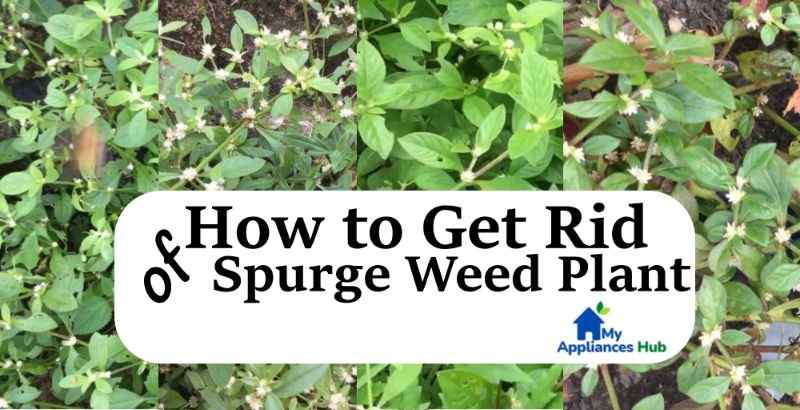
Must Read Articles
- Practical Ways to Kill and Get Rid of Henbit Weed Without Stress
- 8 Effective Ways to Kill and Get Rid of Stink Bugs in Garden Fast
Must-Have Tools to Kill and Get Rid of Spurge Plant
Ortho Spurge Herbicide Weed Killer (#1 Recommended)
If you can follow the Spurge plant control guide and techniques with the various methods and products recommended in this article, you will be able to prevent a spurge weed plant infestation in your lawn, garden, and landscapes. The various control methods that will eliminate, kill, and get rid of spurge weed in your garden, lawn, and in any landscapes recommended here include:

Quali-Pro Prodiamine, Spurge Herbicide Weed Killer (Best Pre-Emergent Herbicide for Spurge)
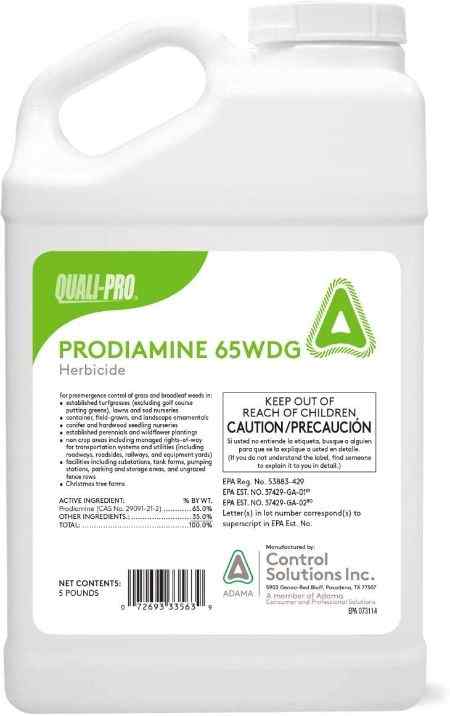
Bonide Spurge Herbicide Weed Killer Granules for Lawn and Garden (Best Post and Pre Emergence Herbicide for Spurge)
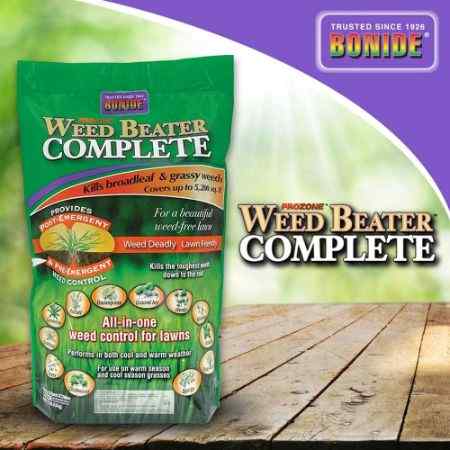
Use Ohuhu Stand-Up Weeder to Remove and Get Rid of Leafy/spotted/prostrate Spurge
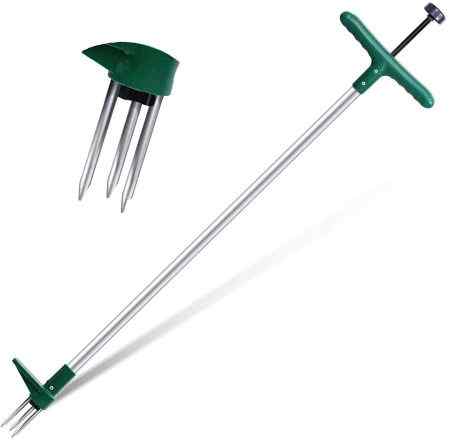
Use Gardtech Garden Tool (5 Pcs) to Remove and Get Rid of Leafy/spotted/prostrate Spurge
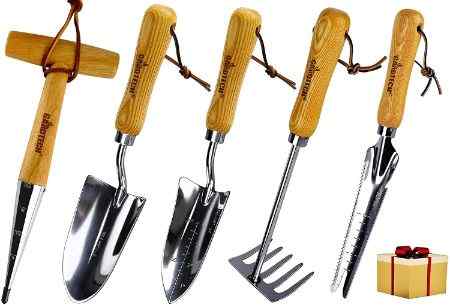
Sole Saver Safety Foot Wear to Protect Yourself from Spurge Plant.
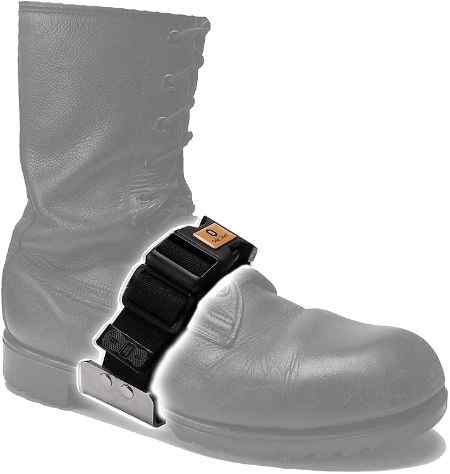
Use Yard-X Multi-Use Garden Tool (5 Tools in One) to Get Rid and Remove Spurge
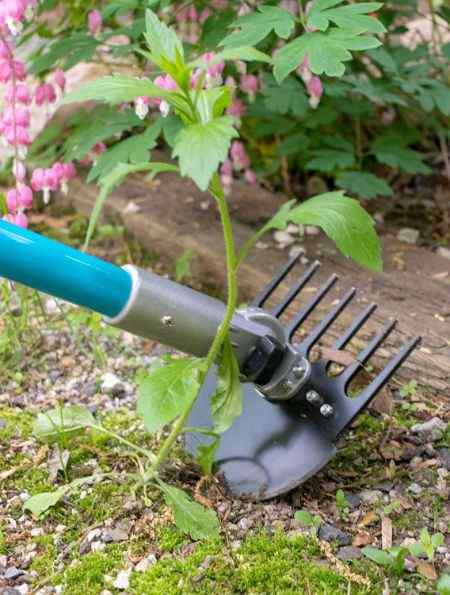
Use Greenworks Cordless Trimmer to Control and Eliminate Spurge In Lawn
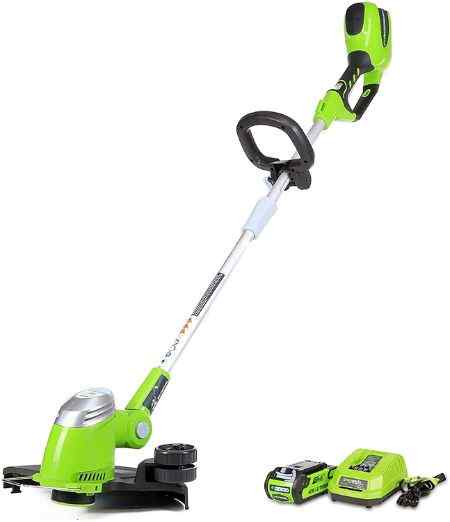
Use Remington to Kill, Control, and Get Rid of Spurge Weed Plant
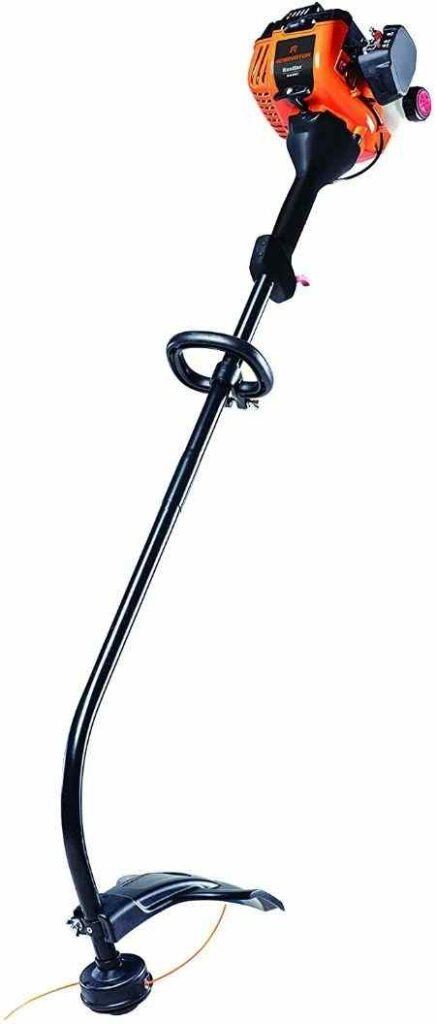
Use Rose Pruning Gloves for Men & Women to Get Rid of Spurge Plant
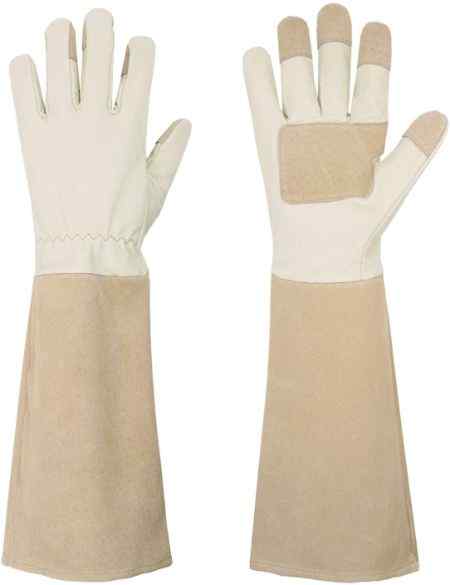
Use Gardening Gloves for Women / Men to Get Rid of Spurge Weed
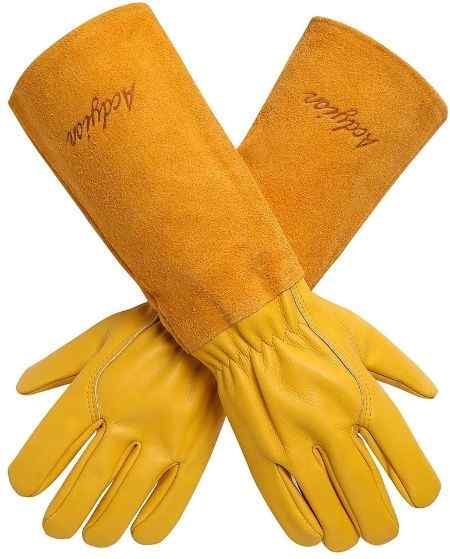
Use 3M GoggleGear to Protect Yourself from Spurge Plant
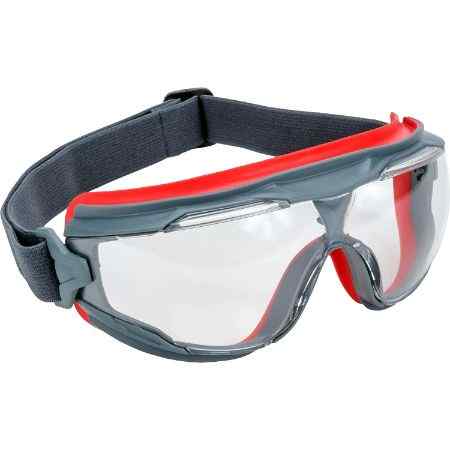
Use Super more Anti-Fog Protective Safety Goggles Against Spurge Weed
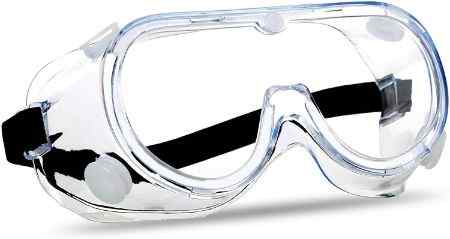
Use LKDEPO 4 Styles Hoe Garden Tool for Spurge Plants
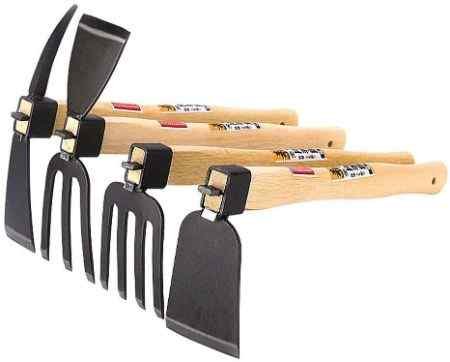
Use YAPASPT Garden Hoe and Cultivator for Spurge Plant
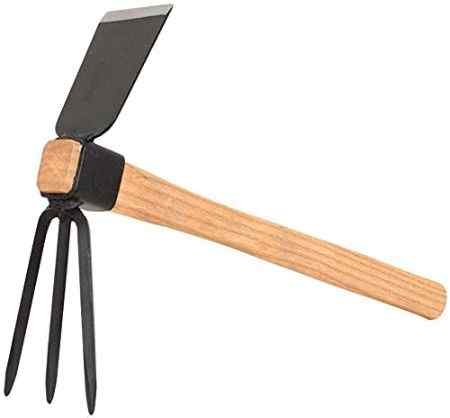
Use Max Backpack Sprayer for Professionals Applying Herbicides for Spurge
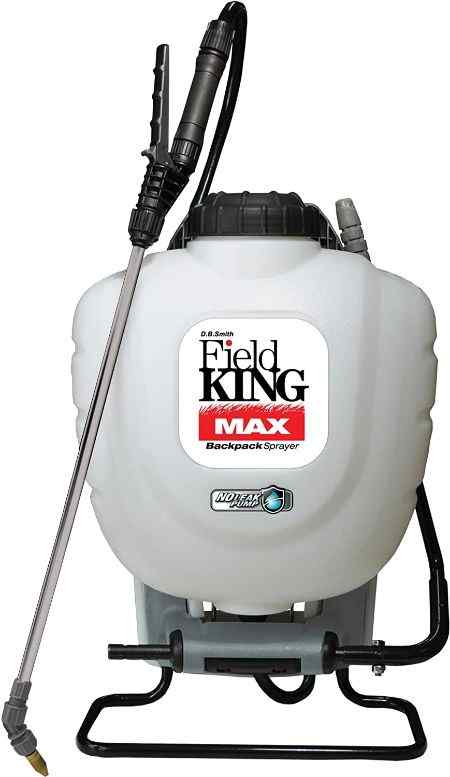
M4 MY4SONS Backpack Sprayer for Application of Herbicides for Spurge (Battery & Charger Included)
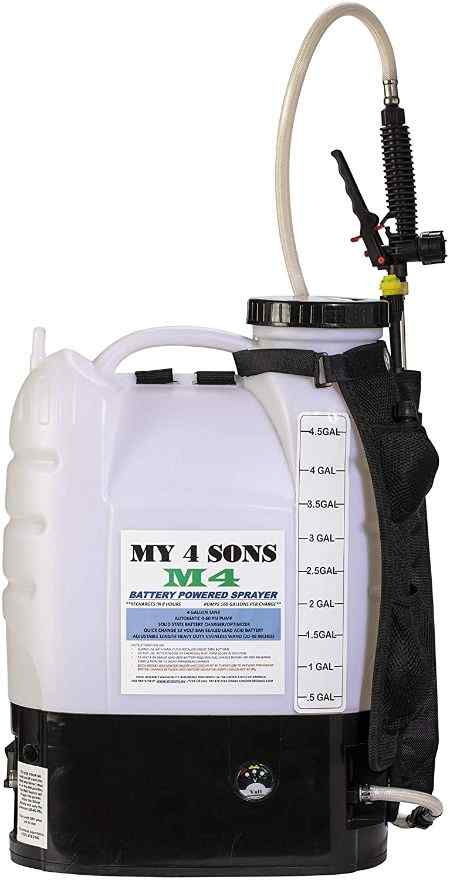
PetraTools Backpack Sprayer for Application of Herbicides for Spurge (Battery-Powered)
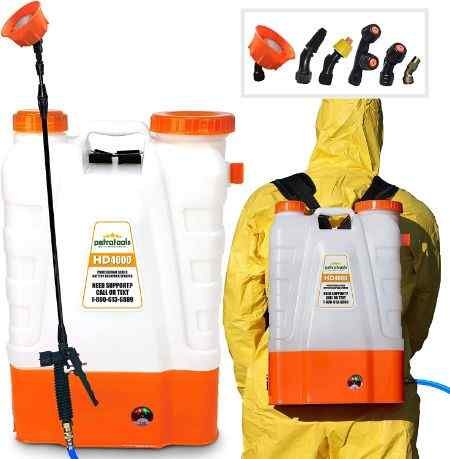
How Do You Control, Kill and Get Rid of Spurge Weed?
Our top recommendation to control, kill and get rid of Spurge Weed is to use herbicides for the spurge plant, as suggested in this article, especially when you have a large coverage area of Spurge.
You can also consider the various natural ways to get rid of Spurge. Hand pulling is an excellent option for removing spotted spurge weed because of its mat-like spread in lawns, gardens, and landscapes. The pulling of the spurge plant should be done early before it develops seeds to prevent it from spreading.
What is the best herbicide for Spurge? Below are the top recommended herbicides for spurge plants that are great for a post or pre-emergent spurge weed control, such as Quali-Pro Prodiamine, Vpg Fertilome, Tenacity, Snapshot TG Granular, Dimension 2EW Dithiopyr, etc. Please scroll down to see our top recommendation of the listed herbicides.
Facts About Spurge Weed Plant
There are many species of Spurge Weed. Below are the most common ones:
- Euphorbia Species,
- Spotted Spurge
- Creeping Spurge,
- Spotted Sandman,
- Prostrate Spurge
- Sun Spurge
Family: Euphorbiaceae
Genus: Euphorbia
Species: Maculata
Synonym: Anisophyllum maculatum/ Chamaesyce maculate/ Euphorbia depressa/ Euphorbia jovetii/ Euphorbia meganaesos
Life cycle: Summer Annual
Growth Habit: Low branching dense mat
Propagation: Seed
Leaf Margin: Toothed at the apex
Height: Average of 6 in. (15 cm)
Foliage Color: Blue-Green
Category: Groundcovers
Sun Exposure: Need Full Sun to Partial Shade, Hate to compete with other plants.
More Facts About Spurge Weed Plant
Leaf Hairs: Spurge is Hairy
Leaf Structure: It is Ovate to oblong and has an unequal leaf base
Flower Color: Inconspicuous between leaves and stem.
Spacing: 12-15 in.; 15-18 in.; 18-24 in
Root Type: Small taproot along with the fibrous root system
Hardiness: USDA Zone 9a: to -6.6 °C (20 °F)
Leaf Arrangement: It is opposite, and the parts of the weed contain a milky sap.
Danger: The plant does cause allergic reaction or skin irritation or
Bloom Color: White/Near White
Bloom Time: It starts blooms in mid-summer to late fall
Essential Details: It is toxic and very invasive
Soil pH requirements: mildly acidic; neutral and mildly alkaline
Regional: Spurge will grow outdoors and in most states of the US, Australia, and Canada. Spurge weed is said to grow aggressively in the form of Arizona, Morrilton, Arkansas, Canoga Park, California, etc.,
What Is Spurge Weed?
Spurge is a common weed and fast-growing that can cause you many problems if not treated timely. It is from the family of genus Euphorbia that is often found in tropical Africa and native to eastern North America. The name “Spurge” was derived and formulated from the old French word “spurge,” which means “to purge something” because it is often used as a purgative for medicinal purposes.
Spurge is an annual summer weed that spreads very fast and grows low on lawns and gardens. The earlier you get rid of and kill Spurge in your garden and yard, the better for you.
How many spurge species are there in the world? According to the latest research and science studies, the genus Euphorbia “Spurge” is one of the world’s largest flowering plants today, with over 2,400 known species. Many of them are highly useful for us as ornamentals that are excellent sources for drugs and can be used directly as weeds.
Is Spurge Weed Poisonous?
Is the milky sap from spurge weed harmful and poisonous to humans, pets, and household livestock? Most species of spurge weeds will cause severe skin irritation, blistering, swelling, and blotching to both pets and humans. If you happen to expose any part of the mucous membranes, it can be hazardous and painful, like your eyes.
It would help if you quickly took precautions and flushed the part of your body with clean water. The sap of species of spurge weeds such as Leafy Spurge, creeping Spurge, spotted Spurge, ground spurge, spurge laurel, or any Spurge you may have in your area will irritate the skin of animals and humans.
The Leafy Spurge (alkaloid euphorbon); is toxic to pets and humans, and it is known in the science world as co-carcinogen. The white latex sap of the Leafy Spurge is very harmful to humans and animals and can result in blindness if in contact with your eyes.
Also, the Myrtle spurge is dangerous and poisonous if ingested and also highly invasive and highly toxic.
Spurge Weed Identification
There are many species of spurge weed, but they all have similar features and characteristics. Spurge weed needs a high temperature to grow (above 60 degrees ) because it is summer. This should be in your mind in the process of Spurge weed identifications.
What to Look Out for in Spurge Weed Identification?
It is easy to identify Spurge weeds that may be growing in your garden, lawn, and landscapes; by looking out for their leaves and stem with unique characteristics, which is still dependent on the species of Spurge weed you are targeting.
The aggressive and invasive species of Spurge weed can grow under any condition, while most species of Spurge will grow in a warmer climate with a lot of sunlight.
To control, kill, eliminate, and get rid of Spurge weed, you need first to know and identify the kind of Spurge weed species you are dealing with. Any wrong identification of Spurge can lead to inappropriate treatment methods that can be very costly in your time and moneywise.
The most common Spurge weed variety in the United States is the Spotted Spurge (also referred to as Prostrate Spurge).
The Characteristics of Spurge Weeds
There are lots of Spurge Weeds, but most of them share the following characteristics:
The Spurge Weeds leaves are arranged in sequence along with their stem one leave in the opposite direction.
The Spurge Weeds always grow very low to the lawn, garden, ground, or wherever you find them.
The broken leave of Spurge Weeds often releases a milky sap that can irritate on contact to your eye and skin.
The Spurge has a taproot or central root. Its weed grows along the stem from the primary source. The stems and leaves tend to have tiny seeds as they extend outward from the taproot. To instantly kill, eliminate, and get rid of Spurge Weed in your garden and lawn, you must kill it from the taproot system.
When Does Spurge Weed Grow?
The Spurge Weed is considered an annual summer weed. This implies that it will grow and die in summer when the soil temperature is over 60 degrees. Spurge weed can start to grow from February and throughout September. It all depends on your location and what the weather is like.
The growing season for Spurge Weed starts when the soil temperature reaches an average of 60 degrees (this helps the Spurge Weed seed to germinate).
The Spurge will usually grow throughout the season until frost occurs. It has been observed that Spurge Weed is a big problem in the southern states of the United States because it has a long season to grow. This is why you need to know how to identify Spurge Weed much earlier and develop a plan to kill, eliminate, and get rid of them quickly.
Most time, the Spurge Weed seeds produced during the latter half of the season will remain dormant until the new spring. This is why the continuous identification, treatment, and early control of Spurge Weed is essential.
Spurge is very aggressive and can quickly overtake your garden and lawn in no time. You need to employ the best Spurge weed killer to eliminate, kill, and get rid of its taproot timely.
Where Does Spurge Weed Grow?
The Spurge weed is a perennial flowering plant that is aggressive and grows wild in lawn, garden, fields, sidewalk cracks, along roadsides, prairies, open woods, forest, and most waste ground. It grows in most of the two-thirds of the eastern part of the United States in the early summer to late summer.
Where Do You Find Spurge In Your Lawn, Garden, And Fields?
Spurge weed needs good sunlight and can easily be seen in the thinly spread lawn with grass. There is a different type of spurge weeds with another characteristic.
When Do Spotted Spurge Plants Start To Grow?
The spotted spurge seed needs sunlight to germinate. Therefore most seeds deep in the soil will not germinate. They grow slowly without you noticing them until late summer. Most time, the spotted spurge weed is killed by frost.
What Kind of Soil Does Prostrate Spurge Grow In?
Prostrate Spurge (Euphorbia humistrata) is an annual broadleaf Spurge weed found in the nutrient-poor soils or sandy and dry weakened landscape sites and compounds. Grow In?
Prostrate Spurge (Euphorbia humistrata) is an annual broadleaf Spurge weed found in the nutrient-poor soils or sandy and dry weakened landscape sites and compounds.
IMPACT Spurge Weed on Garden and Lawn
What is the economic impact of the Spurge Weed on your garden and lawn? The Spurge can quickly establish itself in your lawn, horticultural, garden, noncrop sites, or in any landscape. Significantly, the Spotted Spurge will overgrow in a sparse turf area and invade your open garden and landscapes very low, covering the ground. It is also easy for Spurge to grow along the sidewalk and cracks.
The economic impact of the growth of Spurge Weed are:
- It will reduce the growth of your plants.
- It will affect the quality and the uniformity of your turf.
- The ants and fungal diseases will be attracted to any space where you have overgrown Spurge Weed
- It aids and provides habitation for unwanted insects, most especially in citrus groves
- Some species like the Spotted Spurge are poisonous and can kill life stock, such as sheep grazing within hours.
How Are Spurge Weeds Spread in The Garden?
Spurge weed will grow fast and spread in the form of the mat in your garden and lawn. They thrive well and can quickly form colonies, most where there is an excellent exposure to moisture and sunlight. The early identification of Spurge weed is important for easy control to eliminate, kill, and get rid of them fast in landscape, lawn, and in your garden bed plantings.
How Big Does a Spotted Spurge Plant Get?
Spotted Spurge Plant can spread in mat form and can be over three feet across. The problem with Spurge Plant is that it can produce thousands of seeds per plant that will aid the spread throughout your lawn, garden bed, cracks, and landscapes.
Types of Spurge Weed
There are many types of Spurge Weed species across the state in the US and North American. Below are common varieties and kinds of Spurge weed you may come across near you or in your counties in the US.
Spotted Spurge/Prostrate Spurge
The Spotted Spurge (Euphorbia maculate) is also referred to as the Prostrate Spurge, is an annual plant native to the eastern US states. It is the most common type of spurge family that currently dominates California and many other states in the US.
The Spotted Spurge is a dark green plant with red stems and will always grow very low to the ground like a mat form. Its branches grow both upward and outward when seeking or competing for sunlight. The pink or purple stems of the Spotted Spurge is the fastest way to identify and distinguish it from other species and type of Spurge weed.
Its flower is small and pink in color, while the plant has a hairy appearance. The Spotted Spurge will exude a milky sap when you break the stem into two. The milky juice can irritate your skin if on contact.
The Prostrate or Spotted Spurge is toxic to animals if eaten in large quantities. These Prostrate or Spotted Spurge weeds also invade crops in many states affecting citrus, turf, container ornamentals, ornamental beds, trees, sidewalk cracks, vegetable gardens, and landscaping beds. The good news is that the management of all types of Spurge weed is similar.
You will see a spot or line of maroon at the center of the vein of the Prostrate or Spotted Spurge leaf, which is why it is called spotted Spurge.
How to Control, Kill, and Get Rid of Spotted Spurge/Prostrate Spurge
One of the best ways to control, kill and get rid of Spotted Spurge is to use pre-emergent sprays before the seeds sprout. Another great option without herbicides is solarizing the soil of the affected lawn or garden to kill both the Spotted Spurge and its seeds. The problem with this method is that it will also kill everything else.
It is often easy to kill and get rid of Spotted Spurge in gardens, landscapes, and your lawn. The primary issue is the problem of how to eliminate and prevent Spotted Spurge from growing back.
Spotted Spurge has a firm tab root that is long and deep in the soil with hardy seeds. It often grows back from seed down the soil and via the fragmented root deep the soil.
Another way to control, kill, and get rid of Spotted Spurge weed is:
Hand Pulling Spotted Spurge/Prostrate Spurge
Hand pulling is a great way to control, get rid and remove Spotted Spurge weed in your lawn and garden due to its mat-like nature. The problem is that you will need to equip yourself and wear gloves because of the Spotted Spurge sap that can irritate your skin and hands.
You must ensure that you pull the Spotted Spurge from its tap root, and it must be before it develops seeds to prevent sporadic spreading of your lawn and garden. You should expect it to start growing back from its taproot shortly.
Other ways to kill and get rid of Spotted Spurge weed are Mulching herbicides, and chemical control, which should be used as a last resort.
Creeping Spurge (Chamaesyce serpens)
What is Creeping Spurge all about?
The leaves of Creeping Spurge are egg-shaped with a longer stem that is over 20 inches. You can sight the white flowers of Creeping Spurge in any location, such as where the stem and leaf meet, at the tips of its stems, and in most cases along the stem of the Creeping Spurge weed.
You won’t see any spot on Creeping Spurge leaves. It is what distinguishes them from the Prostrate or Spotted Spurge weed. They have light pale green, pale red, or sometimes white leaves,
How is Creeping Spurge Differ from Other Spurge?
Creeping Spurge can be differentiated from other Spurge by the following:
- The Creeping Spurge does not have hairs on the stems
- Creeping Spurge root at the nodes.
- The leaves of Creeping Spurge are much smaller and rounded.
- It was naturalized in California and can also be found in the eastern state of the US.
How to Control, Kill, and Get Rid of Creeping Spurge
The best way to control, kill, and get rid of Creeping Spurge is to remove them at an early sight and age to reduce their seed production in a significant way. The best way to remove them is manually or call it hand weed.
Hand weeding can be very time-consuming due to the number of spread. But there are some new tools that you can use to remove, kill, and get rid of Creeping Spurge that will help you remove them manually, as displayed in this article.
My best advice is for you to use preemergence herbicides as suggested under “how to control, kill, and get rid of Spurge weed” using preemergence herbicides. I wouldn’t stress myself self-using my hands if I were you.
Petty Spurge
Petty Spurge is found on a well moist and shady location such as cultivated grouds like gardens beds, fields, waste ground, and shrubs.
The Petty Spurge weeds are light green with a green flower that is cup-shaped. It has a slender stem, with over like green leaves.
You should start seeing Petty Spurge weed in your garden around April and October of each year. Petty Spurge is considered very stubborn and resilient to grow back in most challenging conditions and any environment.
Identification of Petty Spurge
Petty Spurge leaves are oval and green with a greenish-yellow flower. Its flowers often have no sepals and petals.
There is an FDA-approved drug developed from petty Spurge for treating some types of skin cancer.
There is every indication that Petty Spurge was imported from Eurasian. Still, it is very invasive and widely distributed in many countries and seen heavily in North America. Petty Spurge can be found almost everywhere in the UK but is known to be scarce in Scotland.
The sap extracted from Petty Spurge is used in rapid cell proliferation. It is used to treat traditional remedies for skin cancers regarding non-melanoma (an FDA-approved drug).
The toxicity characteristic of the milky white sap produced by Petty Spurge has been used in some parts of the world for tipping poisoned arrows.
Spurge Weed Plant Identification – Video
Nodding Spurge (Euphorbia nutans)
Nodding Spurge is an erect summer annual found in fields, roadsides, pastures, and cultivated areas.
It can be as tall as between 3 to 18″ tall. It is also spread and low but not like that of prostrate Spurge. Nodding Spurge has a pinkish-red stem that is hairless, round, though with some few fine hairs on its new growth.
The opposite leave of Nodding spurge is about 2″ to ¾” long. The lower surface of its leaves is light green, while the upper surface is red in the middle. You may see some fine hair along the base of each leaf. Its blooming period is usually from the center of summer to fall, lasting for more than two months.
It has a fibrous root system that consists of a central taproot that is considered to be slender. Nodding Spurge does well in full sunlight, poor soil, and in a dry condition. It will do well in soil that contains a significant amount of clay, gravel, and sand soil. The Nodding spurge plants can readily reseed themselves in sunny open areas.
The best way to control, kill, and get rid of Nodding spurge is to identify early and treat them before their seed germinates to avoid sporadic spreading.
How to Control, Kill, and Get Rid of Spurge Weeds with Pre-Emergent Herbicide
There is a need to consider using pre-emergent herbicide treatment to control, kill, and get rid of Spurge Weed in the garden, grass, and in your lawn at Home.
However, the pre-emergent herbicide option should be used to prevent Spurge Weed either (spotted or prostrate) before they emerge or bloom.
The use of the pre-emergent herbicide treatment for spurge treatment is excellent and good to go if you previously had a spotted or prostrate spurge weed problem in your lawn, garden, or grass.
It is essential to know the following before considering using the pre-emergent herbicide to control, kill, and get rid of either prostrate or spotted spurge weed:
What to Know Before Using Pre-Emergent Herbicide for Spurge Weed Plant
- Pre-emergent herbicide treatment will not kill the existing spurge weed or dormant seeds (will not also stop germination from occurring). But they will kill and get rid of the spurge weed seedlings during germination.
- It is the reason why the Pre-emergent herbicide must be applied to spurge weed in your lawn, garden, yard, and flower bed just before the spurge weed seeds emerge.
- If you sight the spurge weed seeds, then it is too late. You can then consider post-emergent herbicide spurge treatment.
- Go for pre-emergent herbicide treatment that is labeled for spurge (as listed in this review down below); this is to be sure that it is okay to be used to kill, control, and help you get rid of the spotted or prostrate spurge weed in the garden, grass, or your lawn.
- Pre-emergent herbicide should be applied before the soil temperatures get to 55 degrees in the spring so that the herbicides products can be present when the seeds start to germinate. Both prostrate and spotted spurge starts to grow when the temperatures reach 60 degrees.
Also:
- The herbicide for pre-emergent treatment of spurge weed for the fall should be applied as soon as the temperature drops below 85 degrees. Ensure that it is before the first frost takes place every year.
- The pre-emergent herbicide treatment of spurge for the spring can be made before the temperature rises, and your weed starts to germinate. You can contact the local county extension office at the Home and garden information center for the required timing for your location in the US state.
- Ensure you go through the label for specific instruction on the usage of any pre-emergent herbicides for spurge treatment you decide to use to observe the teaching of usage. You will need to know what to do, like watering your lawn or garden after the application.
Below is the best pre-emergent herbicide spurge weed killer for use in your lawn, garden, landscapes, and yard:
Use Quali-Pro Prodiamine – Pre-Emergent Herbicide Spurge Weed Killer (Pre-Emergent Herbicide)
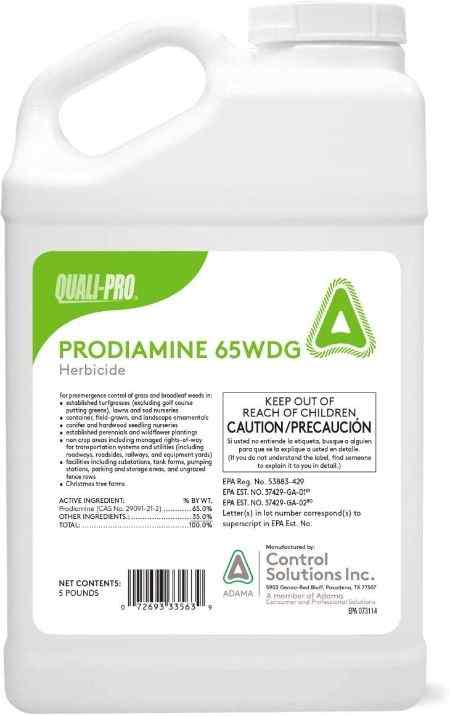
- It is a Pre-Emergent Herbicide and of the best-spotted spurge weed killer in the market. It can be used to control, kill, and get rid of spurge for your garden, lawn, yard, and landscape for both spring and fall use. You will get this product for a 5-pound bottle.
- It mixes great with iron solutions and fertilizers.
- You can be used on Turf, Nurse, Golf Courses, and Landscape.
- It will kill and get rid of spurge, but it is an excellent spurge weed control for prostrate and spotted spurge in grass, garden, lawn, yard, and landscape.
- The active ingredient in this best spurge weed killer is Prodiamine (65%)
Use Vpg Fertilome to Control, Kill, And Get Rid Of Spurge (Pre-Emergent Herbicide)
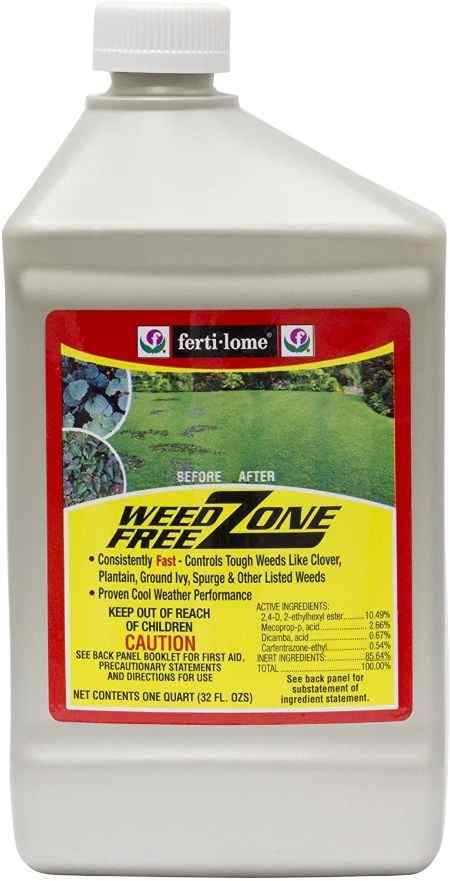
- It is one of the best weed killers for spurge because it consists of 32 Oz Concentrate Formulation (Carfentrazone plus 24-D Mecoprop-P Plus)
- Will not only kill and get rid of spotted/prostrate spurge weed but will also kill, control, and get rid of over 80 other toughest broadleaf weeds such as ground Ivy, Clover, Chickweed, Wild Onion, Virginia Button Weed, Purslane, Henbit, etc.,
- It should not be used above 85 Degrees F. It has excellent performance and impact and acts fast on tough weeds.
- You don’t need to assemble the weed after treatment.
Use Tenacity Turf Herbicide to Kill, Control, and Get Rid of Spurge Weed (Pre-Emergent Herbicide)
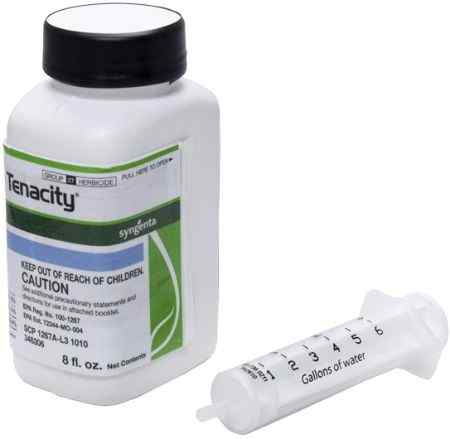
- Tenacity is one of the best spotted/prostrate spurge weed killers of all time because it is a system for pre-and post-emergence herbicide for selective contact for killing, controlling, and getting rid of spurge weed in turfgrasses.
- Spotted/prostrate spurge weed will absorb Tenacity when applied as a pre-emergent when the weed is emerging from the soil.
- It will target and control, kill, and get rid of not only prostrate spurge but also Henbit, Purslane, Dandelion, Wild Carrot, Goosegrass, Foxtail, etc.,
- The active ingredient in Tenacity that kills, control, and gets rid of spurge is Mesotrione (40%).
Note: Ensure you follow all the instructions written on the products before usage. Also, know that date written on Tenacity is the manufacture date and not an expiration date.
Use the Andersons Barricade Professional-Grade to Kill, Control, and Get Rid of Spurge Weed (Pre-Emergent Herbicide)

- Andersons Barricade is another best weed killer for spurge. The granular pre-emergent spurge weed killer will cover up to 5,800 sq ft.
- Andersons Barricade spurge weed killer should be applied only in the early spring and fall.
- Andersons Barricade spurge weed control in the grass, garden, l, and landscapes will prevent weeds and not eliminate the existing spurge in your garden and lawn.
- The active ingredient in Andersons Barricade spotted spurge weed control is Prodiamine (0.48%)
- Professionals well trust the Andersons Barricade to kill, eliminate, and get rid of all your spotted, prostrate spurge weed when applied according to instruction in the label.
Use Snapshot TG Granular to Kill, Control, and Get Rid of Spurge (Pre-Emergent Herbicide)
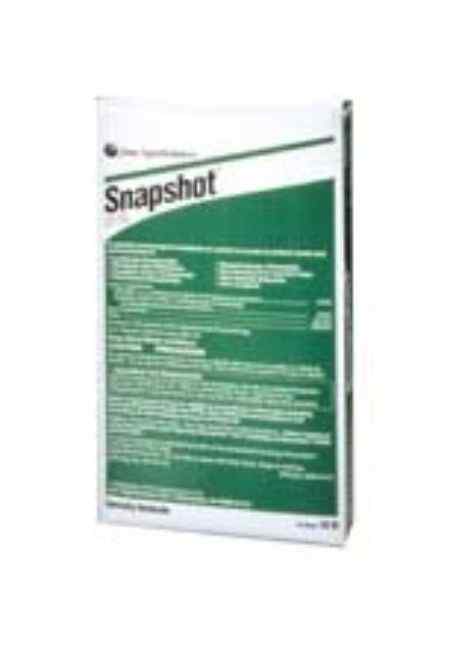
- Snapshot is another great spurge weed killer because it provides more control of spurge and other common weeds in the garden, lawn, yard, and landscape than other pre-emergent herbicides.
- It will prevent and control spurge weed for up to 6 to 8 months.
- The rate of application is between 2.3 to 4.6 lb per 1000 sq feet. ( please use the instruction in the label for practical applications).
- Ensure you apply before irrigation or rainfall
- The active ingredient in Snapshot spurge weed killer is trifluralin Abd isoxaben.
Use Dimension 2EW Dithiopyr to Control, Kill, and Get Rid of Spurge Weed (Pre-Emergent Herbicide)
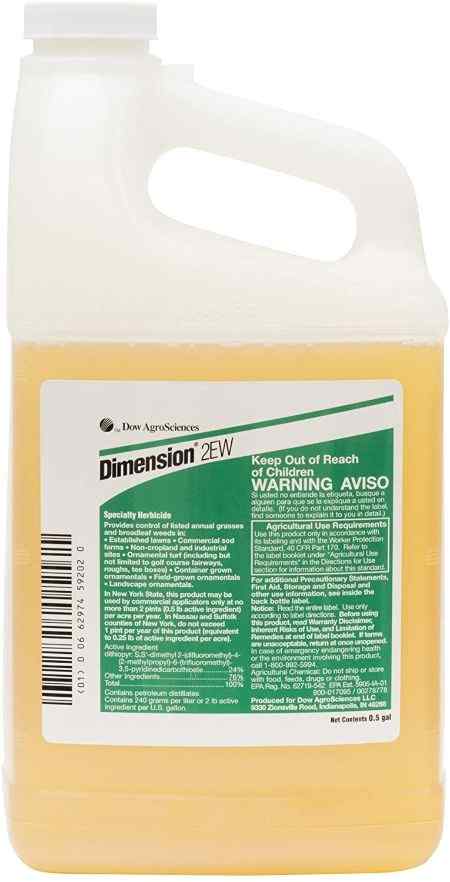
- The Dimension 2EW Dithiopyr is another great spotted/prostrate spurge weed killer.
- That will help you eliminate, control, prevent and kill spurge weed in your garden, lawn, and yard. It is used for pre and post-emergent control of spurge weed.
- It is good to always use the label for practical application of Dimension 2EW Dithiopyr.
- How long can the user wait to reseed after using Dimension 2EW Dithiopyr for pre-emergent? The label shows that reseeding is okay after three months of a single application or after four months of multiple applications.
- You will need 0.55 fluid oz/1,000 square feet of Dimension 2EW Dithiopyr for a gallon of water. The minimum gallon of water for this application is 2 gallons.
Use Granular to Control, Kill, and Get Rid of Spurge (Pre-Emergent Herbicide)
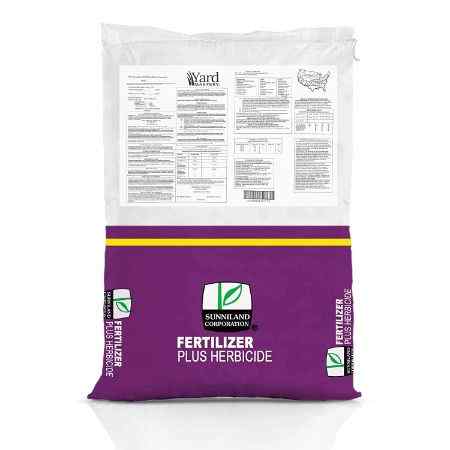
- It is another top herbicide that will help you kill spotted/prostrate spurge fast.
- The primary ingredient in this spurge killer herbicide is Prodiamine (38%)
- Granular can not be shipped to NY.
Use Bonide Weed Beater to Control, Kill, and Get Rid of Spurge (Pre-Emergent Herbicide)
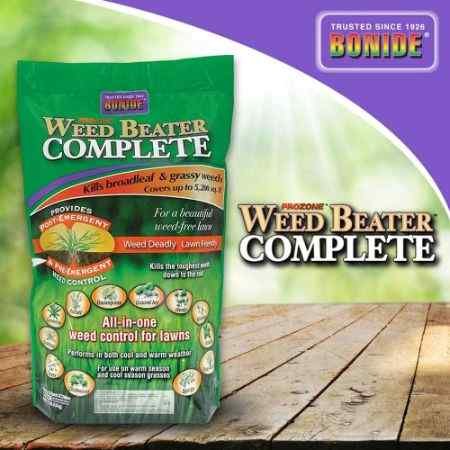
- Bonide Weed Beater is another great spurge weed killer with a complete spurge weed killer that is granules in nature for your garden, yard, lawn, and landscapes.
- The 10 pounds of Weed Beater will help you to control and protect over 5,200 square feet of your yard, lawn, or garden.
- The Weed Beater will serve for both pre-emerging and post-emerging control and protection of your property from prostrate/ spotted Spurge weed.
- The Bonide Weed Beater spurge weed killer will not just kill, control, and help you get rid of spurge; but it will also eliminate and help control other weeds such as nutsedge, crabgrass, goosegrass, ground ivy, etc.,
- The Bonide Weed Beater is a granular and dry application type, and one of the best pre-emergent herbicides spotted spurge weed killer in the market.
- Bonide Weed Beater spurge weed killer is ready to use as soon as you get it to deliver to your door’s steps.
How to Control, Kill, and Get Rid of Spurge with Post-Emergent Herbicide.
Another great way to control, kill, and get rid of spurge weed is by treating post-emergent herbicides. Post-emergent herbicides treatment will take care of active and bloomed weeds in your garden, lawn, yard, and landscapes.
It is essential to identify post-emergent herbicides labeled for spurge to avoid you damaging your garden or lawn. You can also use that post-emergent treatment to control, kill, and eliminate varieties of common weeds in the US (it all depends on your location).
Post-emergent herbicides will work best on Spurge weeds at an early age. Most mature weeds are tough to kill and control. For practical application and results, you have to do multiple treatments. Please use the products label for proper instruction and guidance.
Below is important information you should know about post-emergent herbicides applications as regards spurge:
Top Tips About Post-Emergent Herbicide for Spurge
- The most effective ways to kill, control, and get rid of spotted/prostrate spurge weed are chemical control and treatment. Spurge is a tough weed to kill and control manually because of its extensive and robust root system and the capacity to produce seed fast and spread sporadically beyond control.
- The best way to put spurge under firm control is never to have allowed it to grow in the first place.
- Always use your safety tools and equipment whenever you are handling and mixing herbicide. Use recommended gloves and goggles for your protection.
- If you have missed the start opportunity for pre-emergent herbicide application, you can control, kill, and get rid of spurge with the post-emergent herbicides treatment and applications.
Below are the best-spotted spurge weed killer products you can get on Amazon right now:
Control, Kill and Get Rid of Spotted Spurge with Monterey Weed Killer (Post-Emergent Herbicide)
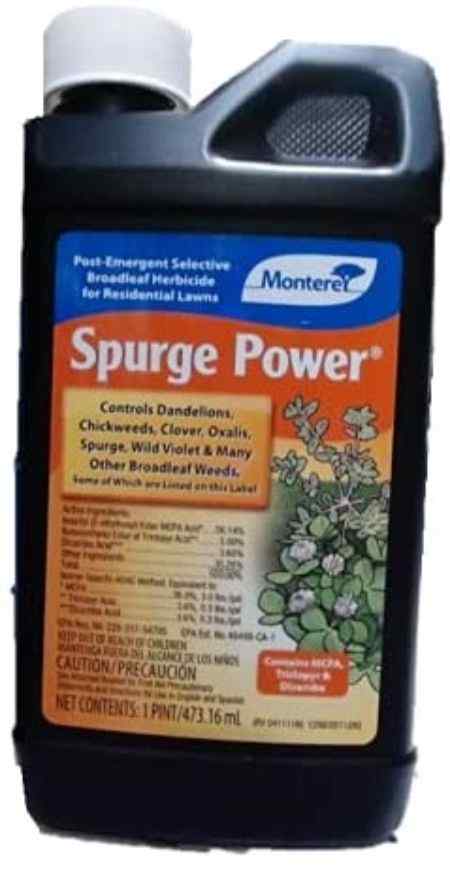
Monterey Spurge Power 16oz is another spurge weed killer that will control, kill, and get rid of other weeds in your garden, lawn, landscapes, and yard.
It can be used as both pre and post-emergent herbicide for spurge plants. It is branded as one of the best weed killers for spotted spurge weed control (spotted and prostrate).
Control, Kill and Get Rid of Spotted Spurge Weed with Triad TZ Select (Post-Emergent Herbicide)
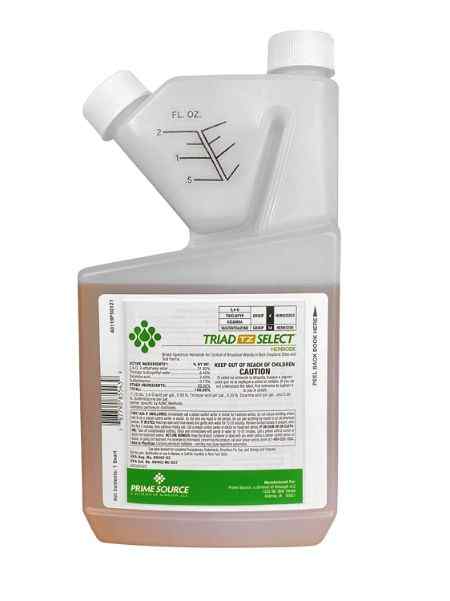
- The Triad TZ Select is another suitable prostrate/spotted spurge killer herbicide for post-emergent with its rapid and very effective weed control when applied.
- It is excellent to kill, control, and get rid of spotted spurge weed and control any other and similar tough broadleaf weeds in its path.
- It contains four primary active ingredients Sulfentrazone, Triclopyr, 2,4-D, and Dicamba.
- As soon as you apply Triad TZ Select. You will be taken by the leaves and stems of spotted spurge weed, and the growth will stop within hours of application.
- It kills the spurge plant instantly, but you will see the real action between 1 to four weeks. It depends on the environment and the rate of application.
- You can be applied on your spotted spurge in residential lawns, yards, parks, industrial, commercial sod production, farmyards, institutional buildings, athletic fields, etc. Ensure you use the label for instruction for usage.
Control, Kill and Get Rid of Spotted Spurge weed with Hi-Yield Weed Killer (Post-Emergent Herbicide)
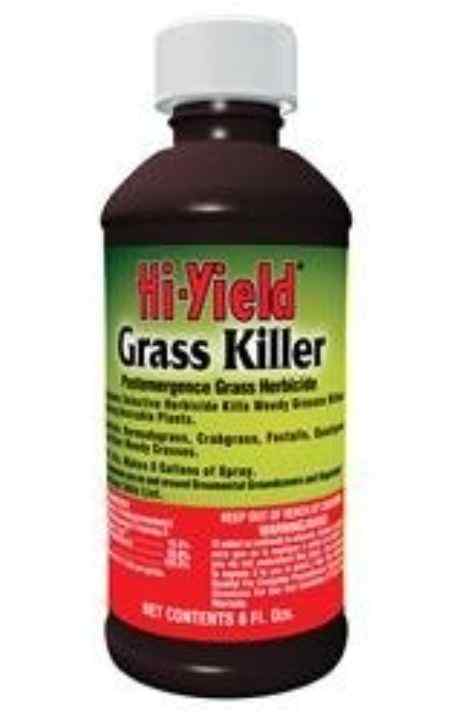
- Hi-Yield is another prostrate/spotted spurge weed killer with its selective ability to kill, control, and get rid of spurge weeds and any other annual and perennial grasses.
- It will stop, kill, and get rid of spotted spurge weed in your vegetables, garden, lawns, yard, shrubs, trees, ground covers, and ornamentals.
- It is easy to apply granules and prevent or kill over 27 other broadleaf weeds and grasses.
- Best to use after weeding to control weeds but does not act reasonably on established weeds.
Control, Kill and Get Rid of Spotted Spurge Weed with Trimec Classic Weed Killer (Post-Emergent Herbicide)
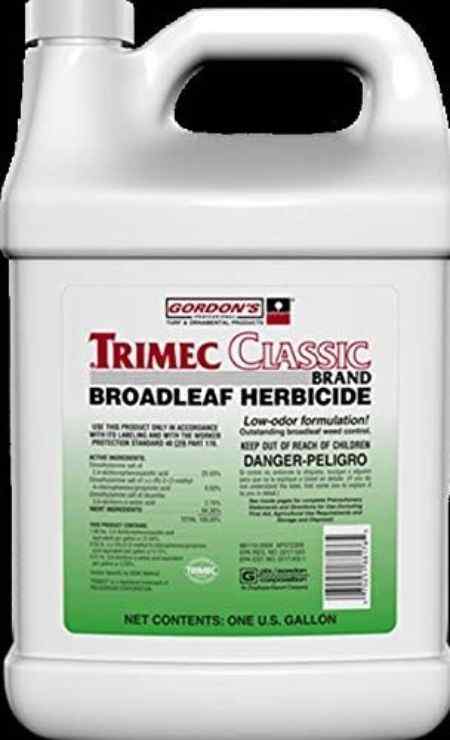
- Trimec Classic is another good prostrate spurge weed killer that is trusted to help you control and get rid of spurge weed and many other difficult weeds that are hard to eliminate in your garden.
- Trimec has been around for over 40 years and is the first broadleaf herbicide spotted spurge killer.
- If you aim to manage acceptable turf effectively, you need to try out Trimec Classic to take control and prevent spurge plants from your garden, yard, landscapes, and in your lawn.
- Trimec Classic will kill, control, and get rid of spotted spurge weed without the requirement for repeated applications.
Control, Kill and Get Rid of Spotted Spurge with Fiesta Selective Weed Killer (Post-Emergent Herbicide)
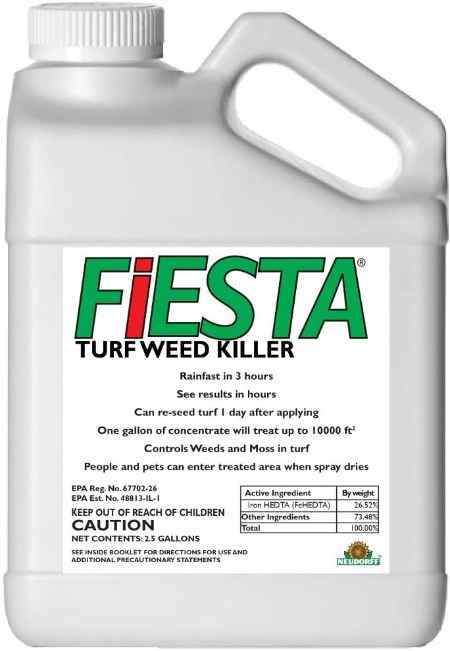
- Fiesta Selective will is one of the best prostrate/spotted spurge weed killers in the market now. It has a patented technology that works both hot or cold, and you will get results on the spurge plant within 24 hours.
- A gallon of Fiesta Selective will cover and treat up to 10,000 sq. ft. of spotted spurge in your yard or lawn.
- Fiesta Selective has a rainfast of 3 hours, and it is the best alternatives to any synthetic chemicals broadcast.
- Fiesta Selective is an odorless liquid that is selective and will kill, control, and get rid of spurge plants in your lawn, garden, yard, and landscapes.
- It is also pet and people-friendly
Selective Herbicide to Control, Kill And Get Rid of Spurge Plant.
One of the best-spotted spurges weed control in your lawn and garden without damaging the main crop is to use the selective herbicide for spurge plant. Below is a list of the best selective herbicide that will kill, control, and get rid of spotted/ prostrate spurge weed plants fast and in no time.
Below is the list of the best selective herbicides for the spurge plant:
Kill and Get Rid of Spotted Spurge Plant with T-Zone (Selective Herbicides for Spurge)
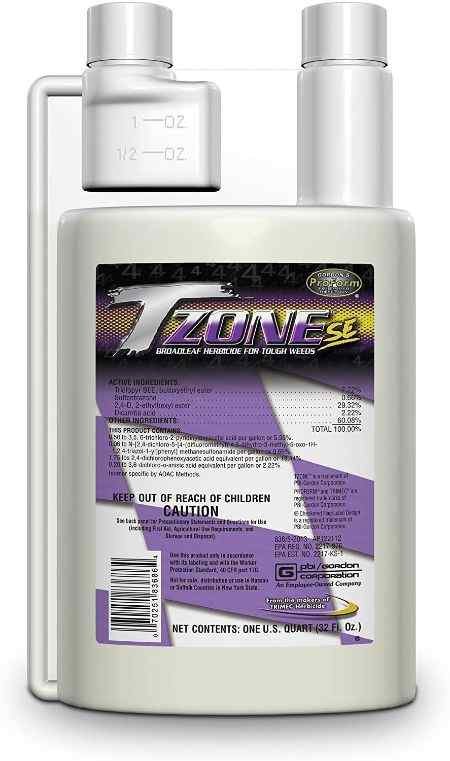
- You can use T-Zone as a selective herbicide for spotted spurge weed control in gardens, grass, and lawn. T-Zone is one of the best prostrate/spotted spurge killers of all time.
- The active ingredient that does the job is Dicamba, 2,4-D, Triclopyr, and Sulfentrazone.
- It is best designed for commercial, lawn care, residential, golf sites, right-of-way, and landscape.
- You can easily see the impact of T-Zone as a prostrate/spotted spurge killer within hours of applications with visible activity.
- It will start killing the prostrate/spotted spurge weeds between 7 to 14 days.
- The active ingredient makes it impossible for chlorophyll production to take place.
- The perfect combination ratio of triclopyr with 2,4-D, dicamba, and fast-acting sulfentrazone makes this product an ideal spurge weed plant killer.
- The Rainfast in as little as less than or equal to just three hours
- These selective herbicides for spurge plant will not only kill spurge plant but will also take care of the following ground ivy, wild blackberry, oxalis, clover, speedwell, yellow nutsedge, lespedeza, etc.,
Kill and Get Rid of Spotted Spurge Plant with Agrisel Grass Out (Selective Herbicides for Spurge)

- Another prostrate/spotted spurge killer is the Agrisel Grass Out. It is also a selective herbicide for spurge.
- The active ingredient is 26.4% of Clethodim.
- It can be used in your home, garden, agricultural and non-crop areas, and any landscape.
- Grisel Grass Out will kill spurge plants and kill and get rid of over 50 varieties of perennial and annual grasses.
- The product will not be sold to NY, HI, AZ, CA, AK.
Kill and Get Rid of Spotted Spurge Plant with Tenacity (Selective Herbicides for Spurge)
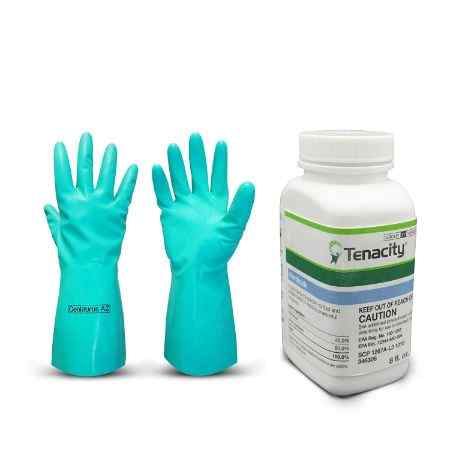
- Tenacity is a great prostrate/spotted spurge killer that is also a selective herbicide for spurge plants.
- You can also use this product for pre-and-post emergence spotted spurge weed control in gardens, grass, and lawn.
- Tenacity will kill spurge weed plants and take care of over 46 other broadleaf grass and weeds species.
- Tenacity is a highly effective spurge plant killer. It is relatively fast to act compared to other selective herbicides for prostrate/spotted spurge.
- This selective herbicide for spurge will not affect or destroy your lawn, and it is highly effective and will prevent prostrate/spotted spurge weed from growing if used often.
- The active ingredient will cease the growth of your prostate/spotted spurge weed (plus other weeds) and prevents the weed’s ability to produce chlorophyll while leaving the excellent turf to remain in your lawn without killing them.
Kill and Get Rid of Spotted/Prostrate Spurge Plant with Quinclorac (Selective Herbicides for Spurge)
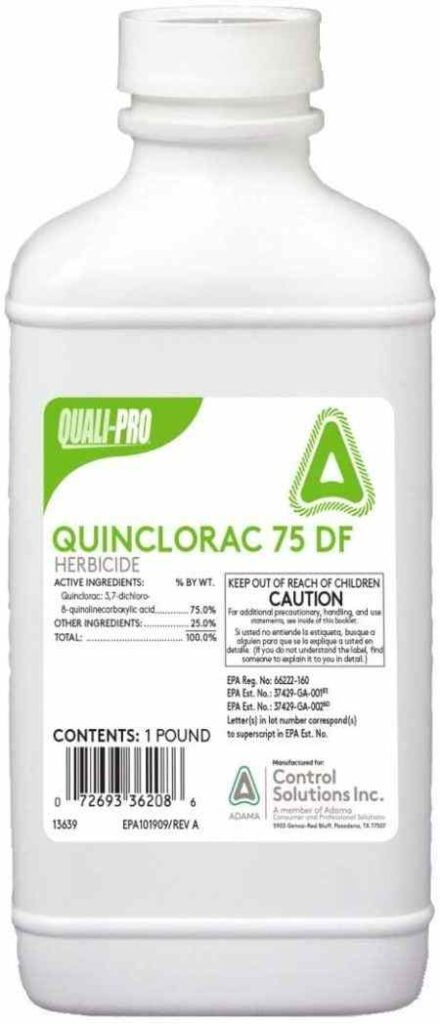
- Quinclorac can be used to kill and get rid of spurge plants in commercial and residential sites and on your sod farms, golf courses, and sports fields.
- It is not just a Spotted/prostrate Spurge killer product but also highly effective to be used for other weed and grass such as Dandelion, Clover, Crabgrass, Signalgrass, Speedwell, Torpedograss, Violet, Morningglory, Dollarweed, etc.,
- The active-active ingredient is 75% of Quinclorac.
Kill and Get Rid of Spurge Plant with Nufarm Triplet SF (Selective Herbicides for Spurge)
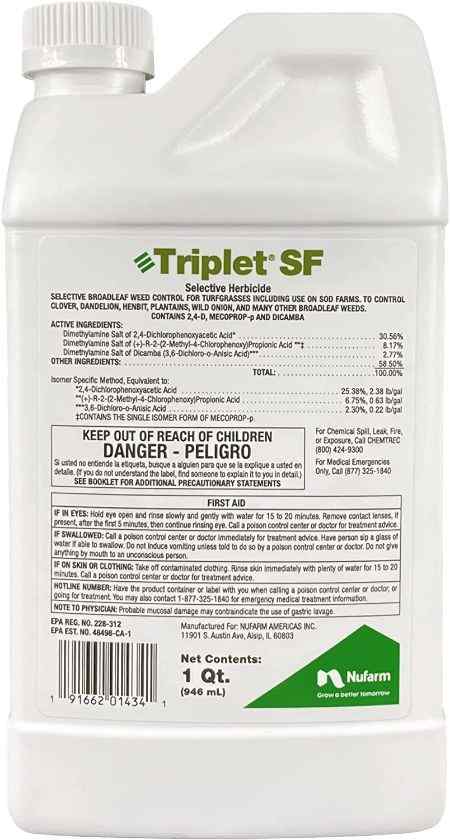
- Nufarm Triplet SF is a combination of three excellent selective herbicides for the spurge plant.
- Nufarm Triplet SF is easy to apply to kill and get rid of prostrate/spotted spurge.
- It can be used on sites such as cemeteries, athletic fields, golf courses, rights-of-way, parks, sod farms, and roadsides, etc.,
- The active ingredients are dicamba (2.77%), mecoprop-p (8.17%), and 2,4-D (30.56%).
Kill and Get Rid of Prostrate/Spotted Spurge with Fusilade (Selective Herbicides for Spurge)
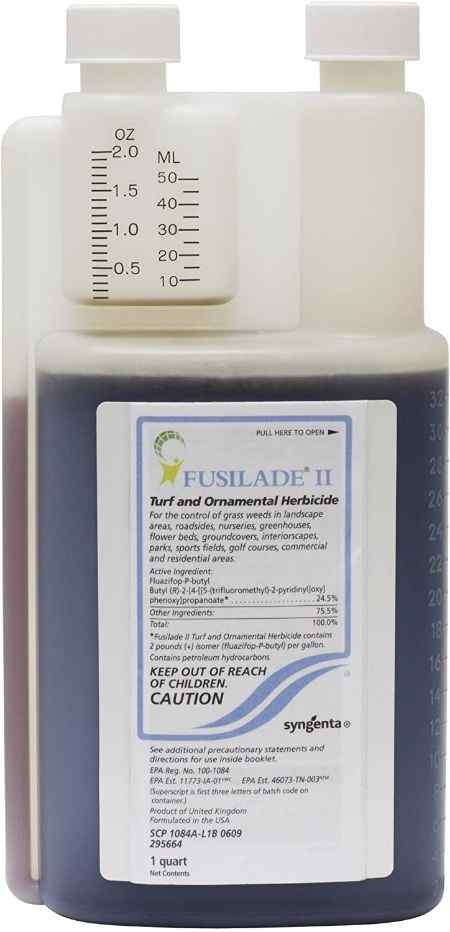
- Fusilade is another great Prostrate/Spotted Spurge killer that will be selective.
- It is also for post-emergent use for spurge plants and weeds.
- 0.75 ozs per gal will cover your 1000 sq. ft. of lawn.
- It would help if you used Fusalide with a nonionic surfactant.
Kill and Get Rid of Prostrate/Spotted Spurge with Blindside (Selective Herbicides for Spurge)

- Blindside selective herbicide for spurge is also for particular post-emergent use for spotted spurge weed control in gardens, grass, and lawn.
- It is also great for over 70 broadleaf weeds.
- Blindside will kill and get rid of spurge plants by attacking the roots and foliar contact.
- You can also use inside spurge weed killer to kill and get rid of buttonweed, dollar weed, and dove weed.
- Blindside spurge plant killer will start working as early as one week after application. You can see the impact on spotted spurge weed in your garden, grass, and lawn quicker than most selective herbicides for spurge.
- One great advantage of using Blindside selective herbicide for spurge is that it works on your soil to prevent spurge plants from germinating the following year.
- For you to get the best out of the Blindside selective herbicide for spurge plants, ensure you use it according to the instruction stated on the label.
- Blindside selective herbicide will also treat over 70 broadleaf weeds and sedges.
Kill and Get Rid of Spurge Plant with Whitetail Institute Arrest (Selective Herbicides for Spurge)
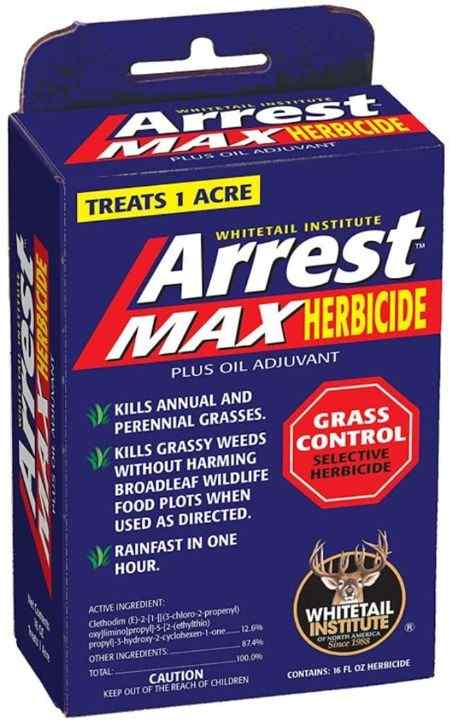
- Whitetail Institute Arrest is another excellent selective herbicide for spurge plants that will also kill and get rid of other weeds instantly.
- It is specifically developed for use for deer food plots.
- Whitetail Institute Arrest Max Selective Grass Control Herbicide Specifically Developed for Deer Food Plots.
- Arrest max will treat spotted spurge weed control in the garden, grass and lawn, and most grasses in your lawn.
What Are Selective Herbicides for the Spurge Plant?
Selective herbicides for spurge are herbicides that you can use to kill, control, and get rid of spurge plants in your garden and lawn without damaging the main crop. Selective herbicides will help you kill, control, and get rid of spotted spurge plants based on species and various categories.
How do Selective Herbicides for Spurge Plants Work?
Selective herbicides will be applied directly to spurge plants in your lawn and garden. As soon as it is used, the herbicides will be absorbed by the spurge plant leaves. It instantly penetrates the spurge leaves, stems, and down the roots of the weeds.
Selective herbicides are made to go after the vascular system of the spurge plant by blocking its growth process and will kill, eliminate, and get rid of the spurge plant within days. The excellent news about selective herbicide on how it works is that the active ingredients know the difference between the target and non-target plants (i.e., selective).
The Selective herbicides will only go after the main spurge plant in your lawn and garden and protect the garden crop from getting harmed by the active ingredients of the herbicides.
Natural Way to Get Rid Spotted/Prostrate/Leafy Spurge
One of the best ways to control, kill, and get rid of spurge plants is through various natural methods. It has been highly recommended that natural control is the best way to eliminate and manage Leafy Spurge Noxious Weeds. It has been discovered that there is no single chemical control treatment that can kill and eliminate Leafy Spurge Noxious Weeds.
Below are various natural ways to kill, control, and get rid of spurge, especially the stubborn leafy spurge noxious weeds. The different natural treatment of spurge plants is split into mechanical, cultural, and biological control.
Other ways to prevent and get rid of spotted/prostrate spurge by preventing it from your lawn and garden naturally are:
***Create a Broad Lawn to Crowd Out Spotted/Prostrate Spurge Weeds***
Spotted/Prostrate Spurge is very good in using any space because they are very aggressive in growing wide in gardens and lawns.
You can keep out spurge by feeding your lawn regularly and keeping them tick without space for any strange weeds like spotted/prostrate spurge.
It is also essential to always mow at the right time and keep them at an excellent height to help keep out spurge by preventing the sunlight they need to survive, which will prevent them from growing.
***Purchase Seeds and Plants That Is Free of Weed***
It is essential to always go for only seeds and plants that are free of weeds. However, state and federal are regulating the percentage of weed in crop seeds. Ensure you always check the seed packet label to ensure you are buying the seeds for your plants.
Be sure that the balled-and-burlapped plants are free of weeds before planting. Look out for perennial and stubborn weeds such as spotted/prostrate spurge, nutsedge, bermudagrass, and bindweed.
***Pay Attention to Weeds from Borders/Fence***
Ensure you plant with underground barriers to prevent any intrusion of weeds by perennial weeds from any vacant yard or along your fence can cause a lot of damage.
You should pay proper attention to such invasion of your territory by unwanted spurge seeds.
***Do Propper Prostrate/Spotted Spurge Weed Disposal***
There are different ways to dispose of prostrate/spotted spurge weeds. Dead Prostrate/Spotted Spurge weeds can be used for mulching (i.e., after they are left in sunlight for a long while).
You are to ensure that weeds lose their moisture content before usage. It is also not okay to use debris with weed seeds for mulching by all standards. They can be subjected to compost pile by ensuring that all the weed seeds are dead under enough high temperature of over 150°F.
Seeds of non-fully compost debris can introduce erroneously to your garden, lawn, and landscape beds.
***Use Hand Puling to Get Rid of Leafy Spurge Noxious Weeds***
Pulling spurge plants by hand is only advice if you have very few of them on your lawn or garden. And if you are sure you are dealing with the stubborn kind of spurge weed, i.e., “Leafy Spurge Noxious Weeds,.”
Though, hand pulling of spurge will seem to be working but only for a while. The remnant of the root will later sprout out with spurge. It is also easier to pull spurge plants only when the soil is moist. You can try to do the pulling after rain or irrigation is done.
Ensure you observe the following when pulling spurge weed from your garden or lawn:
- Ensure that the main root of spurge plant “taproot” is wholly pulled out to prevent re-growth.
- Using gloves is vital because spurge that is disturbed will produce an irritant white sab to both skin and your eyes, especially when its stems are broken while you pull it from the soil.
- It is also crucial that you use eye goggles while pulling spurge plans to protect your eyes.
- Ensure proper tools like hoes, rakes, and shovels are used while you pull leafy spurge weed.
- Please make sure that all spurge plants are packed after pulling from the soil, other it will grow back in time. Ensure you dispose of all leafy spurge, and other spurge plants in a compostable bag as the recycling and trash service advised.
Recommended Weed Pullers to Get Rid of Leafy Spurge Noxious Weeds
Betus Manual Hand Weeder to Remove and Get Rid of Leafy Spurge Noxious Weeds

Walensee Stand Up Weeder Hand Tool to Remove and Get Rid of Leafy Spurge Noxious Weeds.
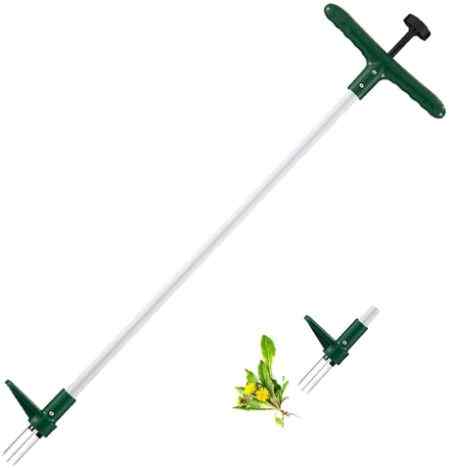
Sun Joe Cutting Swath Garden Tiller/Cultivator to Remove and Get Rid of Leafy Spurge Noxious Weeds
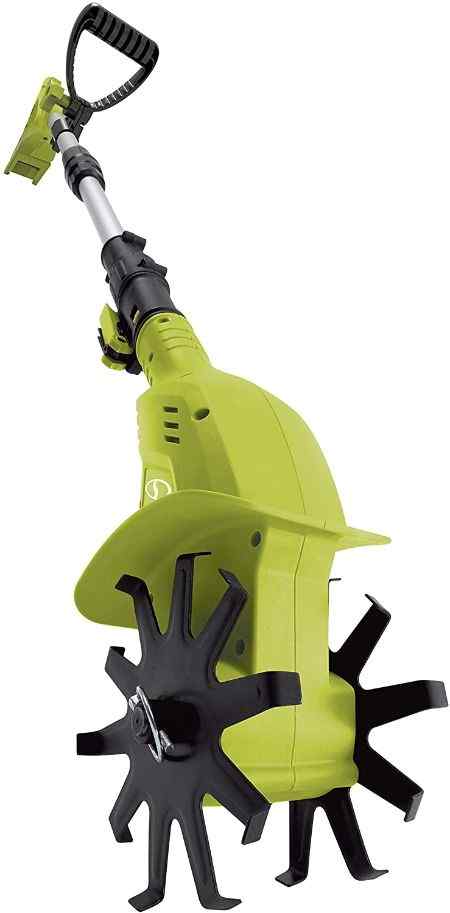
Use Weeding or Cultivating to Get Rid of Leafy Spurge Noxious Weeds.
Using weeding or cultivating is another natural way to get rid of spurge plants (especially the Leafy Spurge Noxious Weeds) in your garden, lawn, and any landscapes.
You need to continue to monitor Leafy Spurge in the infested path of your homes. It is the best way to kill, control, and get rid of Leafy Spurge mechanically in your lawn or garden.
Japanese Gardening Sickle Thick Blade to Kill and Get Rid of Spurge Weed Plant
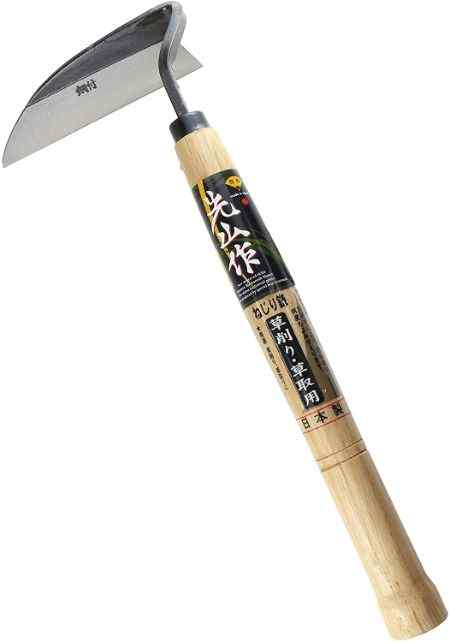
Edward Weeding Tool to Kill and Get Rid of Spurge Weed Plant
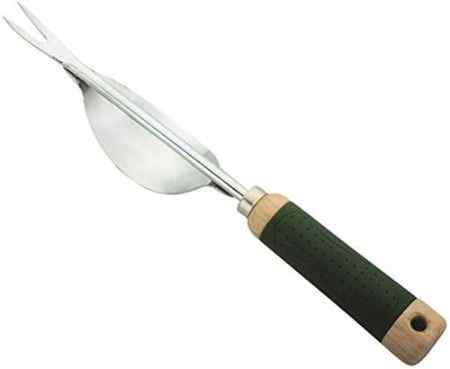
Use Mulching to Get Rid and Control Spurge Weed In Lawn And Garden.
Mulching is a natural way to kill, get rid and control spotted/prostrate spurge weed in gardens, grass, and lawn. Mulching is a reliable way you can use to prevent light from reaching spurge weed seeds that will prevent it from germinating. Even if it germinates, it will quickly dry up without the much-needed sunlight.
You can use so many materials for mulching: bark, wood chips, cardboard, newspapers, shredded leaves, and pine needles.
My recommended mulching materials are synthetic ones like geotextile fabrics and plastic. They are great to be used, but you must watch out for them as they degrade in quality to prevent weeds from growing on them.
Below are us to recommendation spurge plant weed barrier for your considerations:
Use ECOgardener Premium to Kill and Get Rid of Leafy Spurge Noxious Weeds
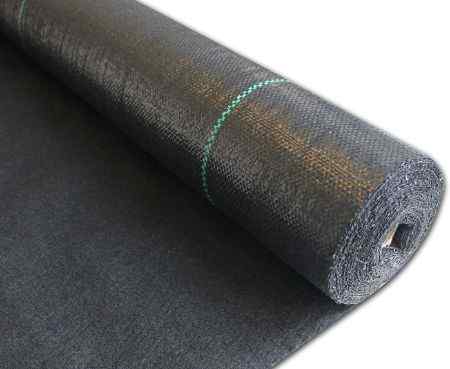
Use Farm Plastic to Kill and Get Rid of Leafy Spurge Noxious Weeds
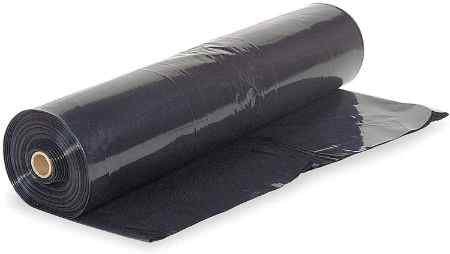
Use Hoeing to Get Rid and Control Spurge Weed In Lawn And Garden.
Hoeing is another natural way to eliminate, eliminate, and control spotted/prostrate spurge weed plants in gardens, grass, and lawn. Hoeing should be done when the spurge plant is tiny; otherwise, it can be overwhelming.
It is recommended that you hoe about three times after rainfall. Hoeing will prevent the weed seed from germinating and prevent the weeds from getting established.
Below are recommended hoes for the spurge weed plant:
Bully Tools Gauge Warren Hoe with Fiberglass Handle
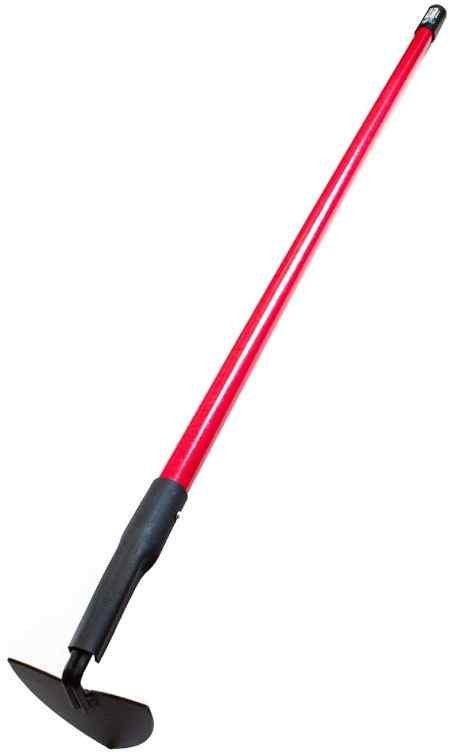
Truper Tru Built 54-Inch Welded Garden Hoe, 6-Inch Head, Fiberglass Handle
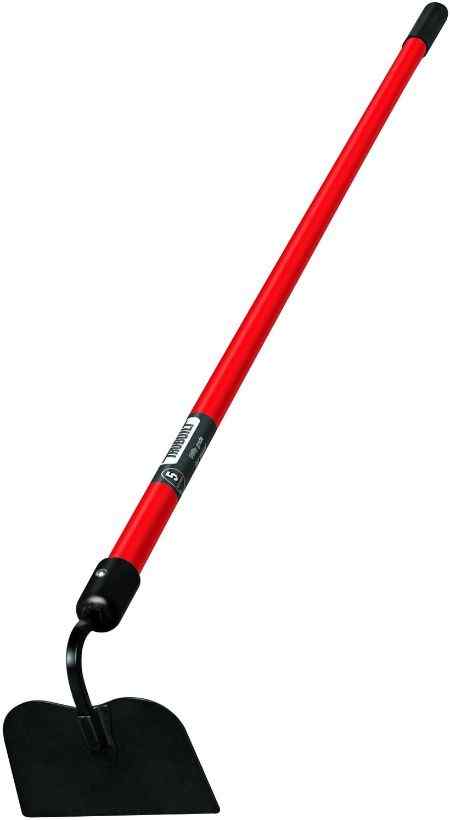
Fiskars Solid Planters Hoe, Length: 32 cm, Fibreglass Reinforced Synthetic Material, Black/Orange, 1001601
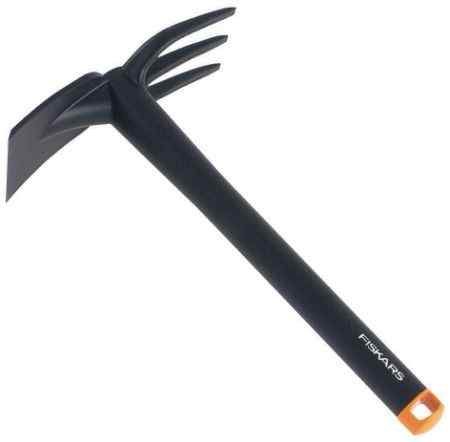
Conclusion on How to Control, Kill and Get Rid of Spurge Weed.
What do you think of the various ways to treat, control, eliminate, kill, and get rid of the spurge weed plant?
You can now control, kill, and get rid of the spurge plant by using either of the following recommendations: Natural way to kill and get rid of spurge weed, selective herbicide for spurge, and pre and post-emergent herbicide treatment.
Follow the complete guide on this page to identify, control, remove spurge with various product recommendations. You will be able to not only prevent spurge from your garden, lawn, and landscapes, but you will be able to eliminate spurge weed 100%. It will require a lot of work, but the task is achievable.